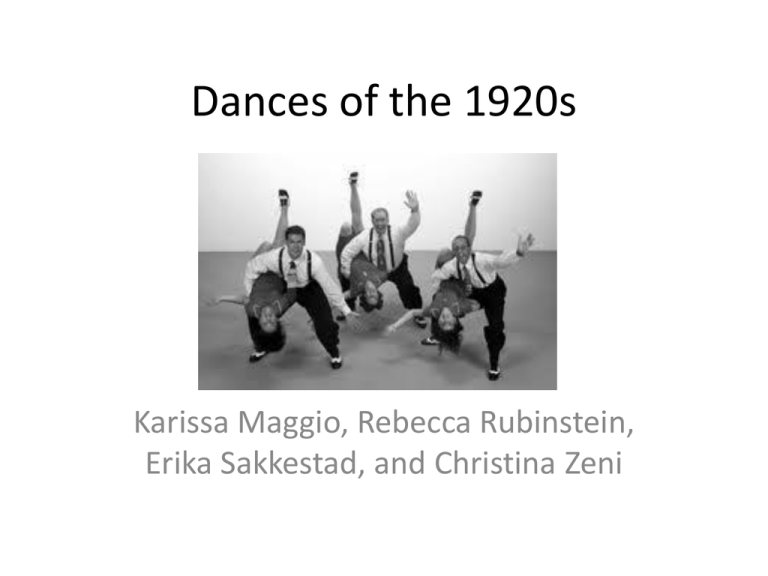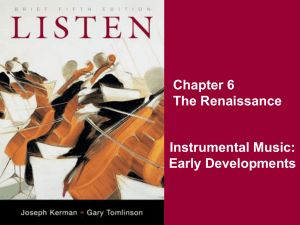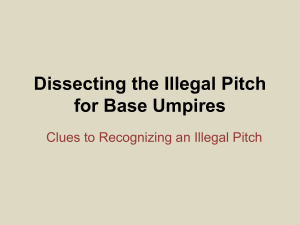Dances of the 1920s
advertisement

Dances of the 1920s Karissa Maggio, Rebecca Rubinstein, Erika Sakkestad, and Christina Zeni The Origins • The horrors and hard times of World War I both home and abroad made people want to release their anger and tension and dance freely to the new happy energetic music, Jazz. • Not all the music was new however. Ragtime remained popular in the Jazz Age, as did older dance styles like the waltz and the foxtrot. The Old and New Dances of the Era Older Dances • Waltz • Foxtrot • Tango • Square Dances • Camel-Walk • Bunny-Hug • Turkey-Trot • Cake Walk Newer Dances • Charleston • Lindy Hop • Shimmy • Toddle • Black Bottom • Blues Dancing • Swing Dancing The Charleston • May have originated on an island off the coast of South Carolina • It became so popular with the African Americans of Harlem, that they introduced it in “Runnin’ Wild,” the Afro-American broadway musical of the Ziegfield Follies in 1923. • Very controversial due to its free (and often incorrect interpretation) of the movements, its involvement with the collapse of the Boston Pickwick Club in 1925, and the scantily-clad flappers who partake in it. • The Charleston’s unique hoofing rhythm is similar to the Foxtrot (in which the first and third beats are accented), but in the Charleston, the first beat and the eighth note before the third beat are accented. This off-beat gives the Charleston its unique syncopated Jazz feel, mirroring the complicated new jazz rhythms created by musicians of the era. Both the dance and the music rebelled against very classical dance and music beats (in which everything was formulaic) which gives the new style its more “free” feel. • It is danced “flat-footed.” • Taught by dance instructors all over the country at that time. • Easily noticeable are the outward heel kicks and the up-and-down movement caused by bending and straightening the knees in time to the music. • Arguably the most iconic dance of the 1920s How do you do the Charleston? • In an article syndicated by the International Feature Service, Oscar Duryea, an expert on American modern dances, gave specific instructions. Good luck understanding them! • “The position at the start is as follows: Man's left foot behind the right, left toe at the heel of the right, both toes turned out—his partner's right foot in front of her left, her right heel at the toe of her left foot, both toes turned out. The man raises the left foot and at the same time raises on the toe of the right, turn both toes in, twisting on the ball of the right foot. With the feet in this position, both toes are twisted out, with the man's left heel in front of his right toe—his partner's right heel in front at her left toe. The man raises his left foot, at the same time rising on the ball of the right foot, and twists both toes in, then puts his left foot behind the right one, and on the balls of both feet twists both toes out—his left toe behind at the right heel. His partner raises her right foot, at the same time rising on the ball of her left foot and twists both toes in, then puts her right foot in front and on the balls of both feet turns both toes out—her right toe in front at her left heel. A toddle movement is taken through-out all the "Charleston" steps, on the foot on which the weight happens to be.” • • • • • • • • • Lindy-Hop Coined after Charles Lindbergh’s first solo flight across the Atlantic Ocean to Paris in 1927. Newspaper headlines read, “Lindy Hops the Atlantic.” The actual dance does not have hops in it. It is rather very smooth and glides. Also known as a form of the jitterbug. Has African, European, and American roots in Swing Dance. The way the partners hold each other and turn is European, while the solid earthy body posture is African. Partners hold each other most of the time, but improvisation is allowed. The music is typically 120-180 beats per minute. Came out of the Charleston, the Black Bottom and earlier Swing Music. Danced mostly for performance, since the combination of aerials and smooth precise movements are very difficult to execute. Films like Hellzapoppin, Day at the Races, Malcolm X, and Swing Kids feature the lindy-hop. The Savoy Theater of New York popularized the lindy-hop. Cake Walk • Originally called the Chalk Line Walk, circa 1850 in Southern Plantations. It became known as the Cake Walk from 1895-1905 and regained popularity in 1915. The African American slaves and Seminole Indians of Florida invented this dance. Seminole couples would walk solemnly. Distinctive movements like the bending back of the body and the dropping of the hands at the wrists were characteristic of African Kaffir dances and the African Ring Shout. • Slaves on the plantation had fun balancing water on their heads and promenading in a dignified manner, making fun of their stiff white masters. Most planters found this very amusing and would hold Sunday contests where the best cakewalking slave would win a hoecake or molasses pulled candy. This is when the dance became known as the “cakewalk.” • Eventually, in the decades after the Civil War, famous cakewalkers like Charles Johnson and Dora Dean, brought their acts to the cities in minstrel shows. Some dancers performed blackface with it while other black and white dancers competed in marathons like the National Cakewalk Jubilee lasting until five in the morning and winning fine jewelry. • The Cakewalk was the first dance to cross the black-white divide and the contestballroom divide. • Although the Cakewalk lost much of its popularity after the 1920s, its influences can still be seen in marching bands, especially those of John Philip Sousa who took his cakewalking bands abroad to London, Russia, France and other destinations. Variations of the cakewalk exist around the world including the strut and in Michael Jackson’s Thriller video. Gallery Lindy-Hop Awesome lindy-hop aerial Foxtrot Charleston Cakewalk equals thriller African American Cakewalk Videos • http://www.youtube.com/watch?v=s58iTzznk p0&feature=related • http://www.youtube.com/watch?v=AcFQjG3Ti Bw • http://www.youtube.com/watch?v=mTg5V2o A_hY Bibliography • http://www.1920-30.com/dance/ • http://www.1920-30.com/dance/charlestondance.html • http://dancing.org/lindy-what-is.html • http://www.streetswing.com/histmain/z3cake 1.htmhttp://www.streetswing.com/histmain/z 3cake1.htm











